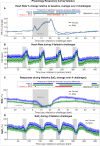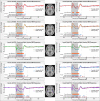Sex Differences in Insular Cortex Gyri Responses to the Valsalva Maneuver
- PMID: 27375549
- PMCID: PMC4899449
- DOI: 10.3389/fneur.2016.00087
Sex Differences in Insular Cortex Gyri Responses to the Valsalva Maneuver
Abstract
Sex differences in autonomic regulation may underlie cardiovascular disease variations between females and males. One key autonomic brain region is the insular cortex, which typically consists of five main gyri in each hemisphere, and shows a topographical organization of autonomic function across those gyri. The present study aims to identify possible sex differences in organization of autonomic function in the insula. We studied brain functional magnetic resonance imaging (fMRI) responses to a series of four 18-s Valsalva maneuvers in 22 healthy females (age ± SD: 50.0 ± 7.9 years) and 36 healthy males (45.3 ± 9.2 years). Comparisons of heart rate (HR) and fMRI signals were performed with repeated measures ANOVA (threshold P < 0.05 for all findings). All subjects achieved the target 30 mmHg expiratory pressure for all challenges. Typical HR responses were elicited by the maneuver, including HR increases from ~4 s into the strain period (Phase II) and rapid declines to below baseline 5-10 s, following strain release (Phase IV). Small, but significant, sex differences in HR percent change occurred during the sympathetic-dominant Phase II (female < male) and parasympathetic-dominant Phase IV (female > male, i.e., greater undershoot in males). The insular cortices showed similar patterns in all gyri, with greater signal decreases in males than females. Both sexes exhibited an anterior-posterior topographical organization of insular responses during Phase II, with anterior gyri showing higher responses than more posterior gyri. The exception was the right anterior-most gyrus in females, which had lower responses than the four other right gyri. Responses were lateralized, with right-sided dominance during Phase II in both sexes, except the right anterior-most gyrus in females, which showed lower responses than the left. The findings confirm the anterior and right-sided sympathetic dominance of the insula. Although sex differences were prominent in response magnitude, organization differences between males and females were limited to the right anterior-most gyrus, which showed a lower fMRI response in females vs. males (and vs. other gyri in females). The sex differences suggest a possible differing baseline state of brain physiology or tonic functional activity between females and males, especially in the right anterior-most gyrus.
Keywords: autonomic; cardiovascular; fMRI; functional neuroanatomy; sympathetic.
Figures





Similar articles
-
Sex differences in insular cortex gyri responses to a brief static handgrip challenge.Biol Sex Differ. 2017 Apr 20;8:13. doi: 10.1186/s13293-017-0135-9. eCollection 2017. Biol Sex Differ. 2017. PMID: 28435658 Free PMC article.
-
Functional organization of the insula in men and women with obstructive sleep apnea during Valsalva.Sleep. 2021 Jan 21;44(1):zsaa124. doi: 10.1093/sleep/zsaa124. Sleep. 2021. PMID: 32592491 Free PMC article.
-
Differential responses of the insular cortex gyri to autonomic challenges.Auton Neurosci. 2012 May 21;168(1-2):72-81. doi: 10.1016/j.autneu.2012.01.009. Epub 2012 Feb 17. Auton Neurosci. 2012. PMID: 22342370 Free PMC article.
-
Executive functions in obsessive-compulsive disorder: An activation likelihood estimate meta-analysis of fMRI studies.World J Biol Psychiatry. 2016 Aug;17(5):378-93. doi: 10.3109/15622975.2015.1102323. Epub 2015 Dec 7. World J Biol Psychiatry. 2016. PMID: 26642972 Review.
-
Functional Imaging of Autonomic Regulation: Methods and Key Findings.Front Neurosci. 2016 Jan 26;9:513. doi: 10.3389/fnins.2015.00513. eCollection 2015. Front Neurosci. 2016. PMID: 26858595 Free PMC article. Review.
Cited by
-
Brain abnormalities in cognition, anxiety, and depression regulatory regions in adolescents with single ventricle heart disease.J Neurosci Res. 2018 Jun;96(6):1104-1118. doi: 10.1002/jnr.24215. Epub 2018 Jan 6. J Neurosci Res. 2018. PMID: 29315714 Free PMC article.
-
Sex differences in insular cortex gyri responses to a brief static handgrip challenge.Biol Sex Differ. 2017 Apr 20;8:13. doi: 10.1186/s13293-017-0135-9. eCollection 2017. Biol Sex Differ. 2017. PMID: 28435658 Free PMC article.
-
The role of lateralisation and sex on insular cortex: 3D volumetric analysis.Turk J Med Sci. 2021 Jun 28;51(3):1240-1248. doi: 10.3906/sag-2010-137. Turk J Med Sci. 2021. PMID: 33754648 Free PMC article.
-
Gender- and Age-Specific Differences in Resting-State Functional Connectivity of the Central Autonomic Network in Adulthood.Front Hum Neurosci. 2019 Oct 17;13:369. doi: 10.3389/fnhum.2019.00369. eCollection 2019. Front Hum Neurosci. 2019. PMID: 31680919 Free PMC article.
-
An Autonomic Network: Synchrony Between Slow Rhythms of Pulse and Brain Resting State Is Associated with Personality and Emotions.Cereb Cortex. 2018 Sep 1;28(9):3356-3371. doi: 10.1093/cercor/bhy144. Cereb Cortex. 2018. PMID: 29955858 Free PMC article.
References
Grants and funding
LinkOut - more resources
Full Text Sources
Other Literature Sources

